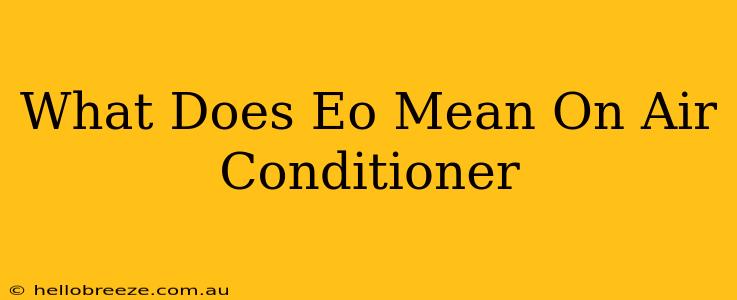Finding "EO" on your air conditioner's display can be puzzling. This article will decipher what this code means and guide you through troubleshooting steps. We'll cover common causes, potential solutions, and when it's time to call a professional HVAC technician.
Understanding the "EO" Error Code
The "EO" error code on your air conditioner isn't a standardized code across all brands. It's crucial to consult your air conditioner's user manual. Different manufacturers use error codes differently. While "EO" might indicate a specific problem for one brand, it could mean something entirely different for another.
Common Interpretations of "EO"
While a universal meaning doesn't exist, some common interpretations of "EO" on air conditioner displays include:
-
Evaporator Coil Problems: This is a frequent possibility. The evaporator coil is a crucial component responsible for absorbing heat from the air inside your home. An "EO" code might signal a problem with the coil's freezing, dirty condition, or malfunctioning fan.
-
External Sensor Failure: Some AC units use external sensors to monitor temperature and other environmental factors. An "EO" error could point to a failure in one of these sensors.
-
Other Electrical Issues: In some cases, "EO" could indicate a broader electrical problem within the AC unit's control system. This could involve faulty wiring, a failing control board, or other electrical components.
Troubleshooting Steps
Before calling an HVAC professional, you can try these basic troubleshooting steps:
1. Check the Air Filter
A clogged air filter restricts airflow, leading to various problems, including the "EO" error. Replace your air filter with a new, clean one. This is the easiest and most often overlooked fix.
2. Inspect the Evaporator Coil (with caution!)**
If you are comfortable working with your air conditioner (always turn off the power before doing so!), carefully inspect the evaporator coil. Look for:
- Ice buildup: Excessive ice indicates restricted airflow or a refrigerant issue. Allow the unit to defrost completely before further inspection.
- Dirt and debris: A dirty coil reduces efficiency and can trigger error codes. Clean the coil gently with a coil cleaning brush or vacuum.
Caution: Do not attempt to clean the coil with harsh chemicals or high-pressure water.
3. Check the Airflow**
Ensure nothing obstructs the airflow to and from your air conditioner, both inside and outside. Clear any obstructions around the outdoor unit.
When to Call a Professional
If the above steps don't resolve the "EO" error, it's best to contact a qualified HVAC technician. Attempting advanced repairs without proper expertise can cause further damage or even create safety hazards. A professional can diagnose the problem accurately and perform the necessary repairs safely and efficiently.
Signs You Need Professional Help:
- The error code persists after basic troubleshooting.
- You notice unusual noises or smells coming from the unit.
- You lack confidence in your ability to safely work with electrical appliances.
- The issue affects the functionality of your entire AC system.
Preventing Future "EO" Errors
Regular maintenance can significantly reduce the chances of encountering error codes like "EO". Consider these preventative measures:
- Regular air filter changes: Change your filter every 1-3 months, or as recommended by the manufacturer.
- Annual professional maintenance: Schedule an annual inspection and tune-up by a qualified HVAC technician.
- Keep the unit clean: Keep both the indoor and outdoor units free from obstructions and debris.
By following these steps, you can better understand and address the "EO" error code on your air conditioner, ensuring a cool and comfortable home environment throughout the year. Remember, safety is paramount, so prioritize professional help when needed.

